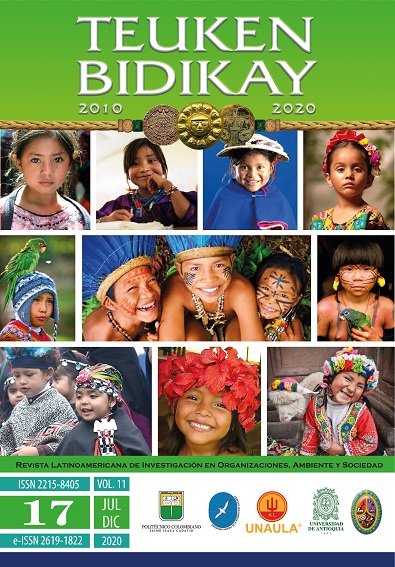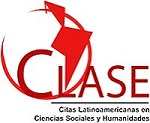Determinants of the intangible asset disclosure for listed companies in Peru
DOI:
https://doi.org/10.33571/teuken.v11n17a3Keywords:
accounting, intangible assets, financial reporting, ifrs, financial disclosureAbstract
The objective of this article is to carry out a descriptive study of the nature of intangible assets and a multivariate analysis to determine if factors such as business sector, investment in intangibles, company size, indebtedness and audit firm influence disclosure compliance. of intangibles in accordance with IAS 38. For this, a content analysis of the annual reports of Peruvian listed companies for the years 2016 and 2017 has been developed around the criteria for measurement and disclosure of intangible assets. The results indicate that the companies, for the most part, invest in intangibles such as licenses and software. Likewise, the sector, investment in intangibles and audit firm are determining factors in the level of disclosure.Article Metrics
Abstract: 1424 PDF (Español (España)): 927PlumX metrics
References
Agyei-Mensah, B. K. (2019). IAS-38 disclosure compliance and corporate governance: evidence from an emerging market. Corporate Governance. The International Journal of Business in Society, 19(), 419-437.
Ahmed, K. & Courtis, J. K. (1999). Associations between corporate characteristics and disclosure levels in annual reports: a meta-analysis. The British Accounting Review, 31(1), 35-61.
Alanezi, F. S.; Alfraih, M. M. & Alshammari, S. S. (2015). Operating Segments (IFRS 8)-Required Disclosure and the Specific-Characteristics of Kuwaiti Listed Companies. International Business Research, 9(1), 136-153. http://dx.doi.org/10.5539/ibr.v9n1p136
Arrarte, R. A. (2015). Contabilidad financiera y valuación de activos intangibles. Quipukamayoc, 23(43), 9-20.
Azevedo, G.; Oliveira, J. & Freitas, M. A. (2019). Compliance with intangible assets disclosure requirements: study of Portuguese non-financial companies. Contaduría y Administración, 64(4), 1-34. http://dx.doi.org/10.22201/fca.24488410e.2018.1705
Bonsón, E. y Escobar, T. (2004). La difusión voluntaria de información financiera en WebWebt. Un análisis comparativo entre Estados Unidos, Europa del Este y la Unión Europea. Revista Española de Financiación y Contabilidad, 33(123), 1063-1101.
Birt, J. L., Bilson, C. M.; Smith, T. & Whaley, R. E. (2006). Ownership, competition, and financial disclosure. Australian Journal of Management, 31(2), 235-263. http://doi.org/10.1177/031289620603100204
Castilla-Polo, F. (2012). Divulgación voluntaria de intangibles y legitimación: La industria productora de aceite de oliva. Intangible capital, 8(3), 564-600.
Chander, S. & Mehra, V. (2011). A study on intangible assets disclosure: An evidence from Indian companies. Intangible Capital, 7(1), 1-30. http://dx.doi.org/10.3926/ic.198
Chow, C. W. & Wong-Boren, A. (1987). Voluntary financial disclosure by Mexican corporations. Accounting review, 62(3), 533-541.
Cooke, T. E. (1992). The impact of size, stock market listing and industry type on disclosure in the annual reports of Japanese listed corporations. Accounting and business research, 22(87), 229-237. https://doi.org/10.1080/00014788.1992.9729440
Darrough, M. N. & Stoughton, N. M. (1990). Financial disclosure policy in an entry game. Journal of accounting and economics, 1990. 12 (1-3). 219-243.
Deangelo, L. (1981). Auditor size and audit quality. Journal of accounting and economics, 3(3), 183-199.
Devalle, A. & Rizzato, F. (2014). The determinants of the quality of mandatory disclosure of intangible assets under IFRS. GSTF Journal on Business Review (GBR), 3(3), 23-29. https://doi.org/10.5176/2010-4804_3.3.320
Devalle, A.; Rizzato, F. & Busso, D. (2016). Disclosure indexes and compliance with mandatory disclosure—The case of intangible assets in the Italian market. Advances in accounting, 35, 8-25. https://doi.org/10.1016/j.adiac.2016.04.003
Depoers, F. (2000). A cost benefit study of voluntary disclosure: Some empirical evidence from French listed companies. European Accounting Review, 9(2), 245-263. https://doi.org/10.1080/0963818005012989
Gandía, J. L. (2003). Intangibles Disclosure Information on Internet by Multinational Corporations. The International Journal of Digital Accounting Research, 3(5), 61-99. https://doi.org/10.4192/1577-8517-v3_3
García, F. y Moya, I. (2009). Efecto de las NIIF en el valor bursátil de las empresas españolas. Investigaciones europeas de Dirección y Economía de la empresa, 15(1), 61-79. https://doi.org/10.1016/S1135-2523(12)60078-1
García, E. y Sánchez, J. P. (2006). Un estudio meta-analítico de los factores determinantes de la revelación de información. Spanish Journal of Finance and Accounting, 35(132), 761-788.
García, M. A. y Zorio, A. (2002). Características de las empresas europeas que aplican las normas del IASC: evidencia empírica de cara al debate regulador en la nueva fase de armonización contable. Spanish Journal of Finance and Accounting, 31(111), 75-110. https://doi.org/10.1080/02102412.2002.10779445
Giner, B.; Cervera, N.; Ruiz, A. y Arce, M. (2003). Incentivos para la divulgación voluntaria de información: evidencia empírica sobre la información segmentada. Revista europea de dirección y economía de la empresa, 12(4), 69-85.
Ibadin, P. & Oladipupo, O. A. (2015). Determinants of intangible assets disclosure in quoted companies in Nigeria. Asian Journal of Accounting & Governance, 6, 13-25. http://dx.doi.org/10.17576/ajag-2015-6-12171
Hayes, R. M. & Lundholm, R. (1996). Segment reporting to the capital market in the presence of a competitor. Journal of Accounting Research, 34(2), 261-279.
Hernández-Pajares, J. (2018). Influencia de la naturaleza internacional de empresas peruanas en su información de sostenibilidad. Revista de Comunicación, 17(1), 74-92.
Herrera, E. E. (2013). Factores que explican la extensión de revelación de activos intangibles de los bancos que cotizan en la Bolsa de Valores de Panamá. Contaduría y administración, 58(3), 173-202. https://doi.org/10.1016/S0186-1042(13)71226-9
Herrera, E. E. y Macagnan, C. B. (2016). Revelación de informaciones sobre capital estructural organizativo de los bancos en Brasil y España. Contaduría y administración, 61(1), 4-25. https://doi.org/10.1016/j.cya.2015.09.007
Jensen, M. C. & Meckling, W. H. (1976). Theory of the firm: Managerial behavior, agency costs and ownership structure. Journal of financial economics, 3(4), 305-360.
Kang, H. H. & Gray, S. J. (2011). Reporting intangible assets: Voluntary disclosure practices of top emerging market companies. The international journal of accounting, 46(4), 402-423. https://doi.org/10.1016/j.intacc.2011.09.007
Lang, M. & Lundholm, R. (1993). Cross-sectional determinants of analyst ratings of corporate disclosures. Journal of accounting research, 31(2), 246-271.
Lang, M. & Stice-Lawrence, L. (2015). Textual analysis and international financial reporting: Large sample evidence. Journal of Accounting and Economics, 60(2-3), 110-135. http://dx.doi.org/10.2139/ssrn.2407572
Larrán, M. y García, E. (2004). La relevancia de la información no-financiera en la estrategia empresarial de divulgación unitaria: percepciones empresa-analista sobre su utilidad, Revista Valenciana de Economía y Hacienda, 12, 127–14.
Leftwich, R. W.; Watts, R. L. y Zimmerman, J. L. (1981). Voluntary corporate disclosure: The case of interim reporting. Journal of accounting research, 19, 50-77.
Lev, B. (2004). Intangibles en la encrucijada. Revista de contabilidad y dirección, 1, 15-29.
Lev, B.; Cañibano, L. & Marr, B. (2005). An accounting perspective on intellectual capital (42-55). En B. Marr (Ed.), Perspectives on intellectual capital. https://doi.org/10.1016/B978-0-7506-7799-8.50008-5
Macagnan, B. (2007). Condicionantes e implicación de revelar activos intangibles. (Tesis doctoral), Universitat Autónoma de Barcelona, España.
Meek, G. K. & Gray, S. J. (1989). Globalization of stock markets and foreign listing requirements: Voluntary disclosures by continental European companies listed on the London Stock Exchange. Journal of international business studies, 20(2), 315-336.
Meek, G. K.; Roberts, C. B.; Gray, S. J. (1995). Factors influencing voluntary annual report disclosures by US, UK and continental European multinational corporations. Journal of international business studies, 26(3), 555-572.
Miihkinen, A. (2012). What drives quality of firm risk disclosure? The impact of a national disclosure standard and reporting incentives under IFRS. The International Journal of Accounting, 47(4), 437-468. https://doi.org/10.1016/j.intacc.2012.10.005
Oliveira, L.; Rodrigues, L. & Craig, R. (2006). Firm-specific determinants of intangibles reporting: evidence from the Portuguese stock market. Journal of Human Resource Costing & Accounting, 10(1), 11-33. https://doi.org/10.1108/14013380610672657
Peruchena, J. L.; Kronbauer, C. A.; Ott, E. y Moreno, J. (2015). Medición y Evidenciación de los Activos Fijos e Intangible en empresas Industriales del Mercosur y la Comunidad Andina. Revista Contabilidade e Controladoria, 7(1), 111-132. http://dx.doi.org/10.5380/rcc.v7i1.37569
Pocomucha, K. y Hernández-Pajares, J. (2019). Influencia de la firma de auditoría y desempeño de empresas cotizadas en la extensión de revelación de información de los reportes anuales. Revista Contabilidad & Sistemas, 16, 46-54.
Ramírez, Z. y Gómez, A.M. (2015). Grado de conocimiento del adjetivo "intangibles", y su relación con la identificación, reconocimiento, medición, valoración y revelación de" intangibles" en la información contable de las empresas en Popayán. Un análisis descriptivo y econométrico. Cuadernos de Contabilidad, 16(40), 111-150. https://doi.org/10.11144/Javeriana.cc16-40.gcai
Rouhou, N. C.; Mrad-Douagi, W. B. Y Hussainey, K. (2015). The effect of IFRS enforcement factors on analysts’ earnings forecasts accuracy. Corporate Ownership and Control, 13(1-2), 266-282.
Salas, J.; Vilchez, P. y Curvelo, J. O. (2017). Claridad y calidad de las notas explicativas en estados financieros bajo IFRS. Un estudio de brechas de Expectativas Gaps para normas contables (NIC 2, NIC 16, NIC 37 y NIC 38). Quipukamayoc, 25(49), 27-40. https://doi.org/10.15381/quipu.v25i49.14277
Santos, E.; Ponte, V. & Mapurunga, P. (2014). Mandatory IFRS adoption in Brazil (2010): Index of compliance with disclosure requirements and some explanatory factors of firms reporting. Revista Contabilidade & Finanças, 25(65), 161-176. https://doi.org/10.1590/S1519-70772014000200006
Singhvi, S. & Desai, H. (1971). An empirical analysis of the quality of corporate financial disclosure. The Accounting Review, 46(1), 129-138.
Valdivia, R.A. (2012). MÁS ALLÁ… DE LA NIC-38 [Una mirada al futuro de los Activos Intangibles]. Quipukamayoc, 20(38), 92-101. https://doi.org/10.15381/quipu.v20i38.4435
Wallace, R. S.; Naser, K. & Mora, A. (1994). The relationship between the comprehensiveness of corporate annual reports and firm characteristics in Spain. Accounting and business research, 25(97), 41-53.
Wallace, R.S. & Naser, K. (1995). Firm-specific determinants of the comprehensiveness of mandatory disclosure in the corporate annual reports of firms listed on the stock exchange of Hong Kong. Journal of Accounting and Public Policy, 14(4), 311-368.
Watts, R. L. & Zimmerman, J. L. (1986). Positive Accounting Theory. Englewood Cliffs, Prentice-Hall.
Wyatt, A. (2008). What financial and non‐financial information on intangibles is value‐relevant? A review of the evidence. Accounting and business Research, 38(3), 217-256. https://doi.org/10.1080/00014788.2008.9663336
Downloads
Published
How to Cite
Issue
Section
License
Copyright (c) 2020 Ivette Estefani Núñez Laguna, Julio César Hernández Pajares

This work is licensed under a Creative Commons Attribution-NonCommercial-ShareAlike 4.0 International License.

























